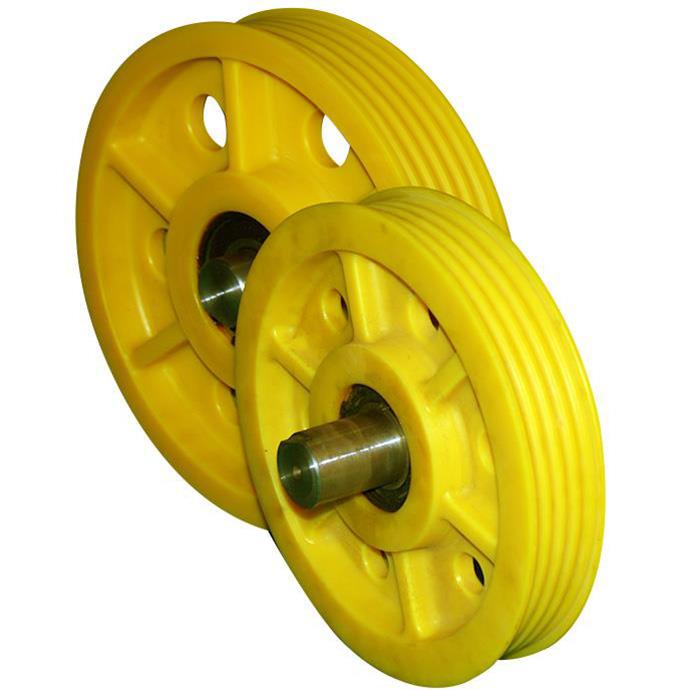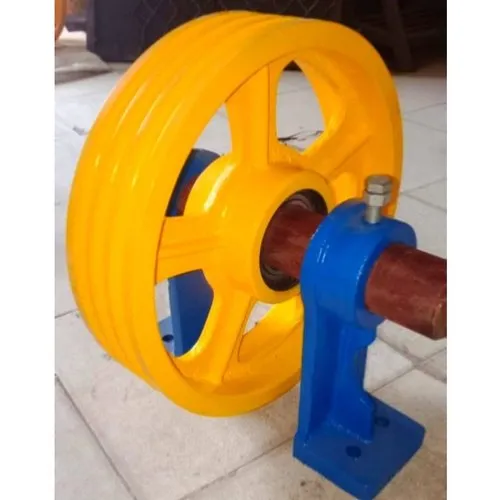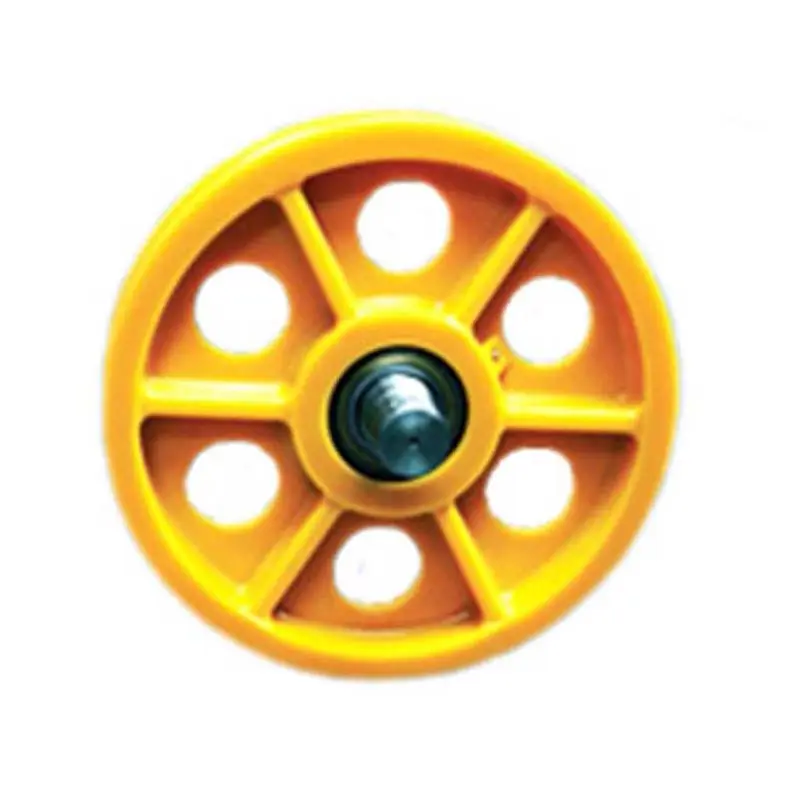Product Description
Heavy Duty Double Sheave Snatch Lifting Pulley Block With Hook
| · Material | Steel |
| · Hook | Yes |
| · Size | 4″ |
| · Type | 1T |
| · Color | Custom |
| · Certification | BSCI, FSC |
| · Advantage | It is for America customer, promotional items |
main features:
1. High-quality materials: the overall body is forged by high-quality steel .
2. Hook: thicken type hook special made for pulley.The hook is precisely forged by round steel with higher bearing capacity. If overload it will not easy to break, it also installs with insurance devices.
3. Lifting pulley: It is forged by high-quality steel, groove design is reasonable. With the coating treatment of the surface, it will not hurt the rope and reduce power loss.
4. High-quality directional wheel: It adopts high grade alloy steel and precisely made with hot quenching, which is durable and high strength.
5. The pulley block can hang in various small crane or installed in fixed on the range.
| Type: | Hook |
|---|---|
| Number of Sheaves: | 1 |
| Control: | Manual |
| Samples: |
US$ 15/Piece
1 Piece(Min.Order) | Order Sample |
|---|
| Customization: |
Available
| Customized Request |
|---|
.shipping-cost-tm .tm-status-off{background: none;padding:0;color: #1470cc}
|
Shipping Cost:
Estimated freight per unit. |
about shipping cost and estimated delivery time. |
|---|
| Payment Method: |
|
|---|---|
|
Initial Payment Full Payment |
| Currency: | US$ |
|---|
| Return&refunds: | You can apply for a refund up to 30 days after receipt of the products. |
|---|
How do you select the right lifting pulley configuration for a specific lifting task?
Selecting the right lifting pulley configuration is crucial for ensuring safe and efficient lifting operations. The appropriate pulley configuration depends on various factors related to the lifting task at hand. Here are the key considerations when selecting the right lifting pulley configuration:
1. Load Capacity: Determine the maximum weight or load capacity that needs to be lifted. This information is crucial in selecting lifting pulleys that can handle the expected load without exceeding their safe working load limits.
2. Lifting Method: Consider the lifting method that will be used, such as vertical lifting, horizontal pulling, or a combination of both. Different pulley configurations, such as single sheave, double sheave, or multiple sheave blocks, are suitable for different lifting methods.
3. Pulley Efficiency: Evaluate the efficiency of the pulley system. Look for pulleys with low friction and smooth-running bearings to minimize energy losses and maximize the mechanical advantage provided by the pulley configuration.
4. Space Limitations: Assess the available space for the lifting operation. Depending on the space constraints, you may need to consider compact pulley configurations or alternative lifting methods that require less spatial clearance.
5. Environmental Factors: Consider the environmental conditions in which the lifting task will take place. Factors such as temperature, humidity, and exposure to corrosive substances may influence the choice of pulley materials and coatings to ensure durability and safe operation.
6. Required Precision: Determine the level of precision required for the lifting task. In some applications, such as delicate installations or precise positioning, a pulley configuration that allows for fine adjustments and controlled movement may be necessary.
7. Accessibility: Consider the accessibility of the lifting area. If the lifting task is in a confined or difficult-to-reach space, you may need to choose a pulley configuration that allows for easy installation, adjustment, and removal.
8. Regulatory Compliance: Ensure that the selected lifting pulley configuration complies with relevant safety standards, regulations, and industry guidelines. Adhering to these standards is essential for maintaining a safe working environment and preventing accidents.
9. Expert Advice: When in doubt, consult with lifting equipment specialists or engineers who have expertise in selecting the right pulley configuration for specific lifting tasks. They can provide valuable insights and recommendations based on their experience and knowledge.
By considering these factors and seeking expert advice when needed, you can select the appropriate lifting pulley configuration for a specific lifting task. The right pulley configuration will ensure safe and efficient lifting operations, minimize risks, and optimize performance.
How are lifting pulleys customized for specific lifting requirements and load capacities?
Lifting pulleys can be customized to meet specific lifting requirements and accommodate different load capacities. Manufacturers offer various customization options to ensure that the pulleys are tailored to the specific needs of the lifting application. Here are some common ways in which lifting pulleys are customized:
1. Load Capacity: Lifting pulleys are designed and manufactured to handle different load capacities. Manufacturers specify the maximum load capacity of each pulley, allowing users to select the appropriate pulley based on their specific lifting requirements. Pulleys can be customized to support light loads, heavy loads, or even extreme loads encountered in specialized lifting applications.
2. Sheave Size and Configuration: The sheave, or the wheel of the pulley, can be customized in terms of size and configuration. Larger sheave diameters provide a greater mechanical advantage, allowing for easier lifting of heavy loads. Manufacturers offer pulleys with different sheave sizes and configurations, such as single sheave, double sheave, or multiple sheaves in a block, to accommodate various lifting needs.
3. Material Selection: The choice of material for the pulley can be customized based on factors such as load capacity, environmental conditions, and industry requirements. Different materials, such as steel, cast iron, aluminum, brass, nylon, plastic, or composite materials, offer varying properties in terms of strength, durability, weight, corrosion resistance, and more. Manufacturers select the appropriate material or combination of materials to ensure that the pulley meets the desired specifications.
4. Bearing Type: Lifting pulleys can be customized with different bearing types to optimize performance and efficiency. Common bearing options include plain bearings, ball bearings, or roller bearings. The choice of bearing type depends on factors such as load capacity, speed, noise requirements, and maintenance considerations. Customizing the bearing type allows for smoother rotation of the pulley, reducing friction and improving overall lifting performance.
5. Mounting Options: Lifting pulleys can be customized with various mounting options to suit different installation requirements. Manufacturers offer pulleys with different mounting configurations, such as fixed mount, swivel mount, or combination mounts, allowing users to select the most suitable option for their specific lifting setup.
6. Special Features: Depending on the specific lifting requirements, lifting pulleys can be customized with special features or accessories. For example, pulleys used in high-temperature environments may have heat-resistant coatings or materials. Pulleys used in corrosive environments may have protective coatings or be made from corrosion-resistant materials. Manufacturers can also incorporate features such as locking mechanisms, integrated lubrication systems, or specialized designs to address unique lifting challenges.
By offering customization options in load capacity, sheave size and configuration, material selection, bearing type, mounting options, and special features, manufacturers ensure that lifting pulleys can be adapted to specific lifting requirements and load capacities. This customization allows users to optimize the performance, efficiency, and safety of their lifting operations.
What types of materials are typically used in the manufacturing of lifting pulleys?
Lifting pulleys are manufactured using a variety of materials, depending on the specific application and desired characteristics. Here are some types of materials commonly used in the manufacturing of lifting pulleys:
1. Steel: Steel is one of the most widely used materials for lifting pulleys due to its excellent strength and durability. Different grades of steel, such as carbon steel or alloy steel, are used based on the required load capacity and environmental conditions. Steel pulleys are capable of handling heavy loads and are resistant to wear, making them suitable for demanding lifting applications.
2. Cast Iron: Cast iron is a popular material choice for lifting pulleys, especially for applications where weight and stability are important factors. Cast iron pulleys are known for their high strength, resistance to deformation, and ability to withstand heavy loads. They are commonly used in industrial settings and applications that require robust and long-lasting pulleys.
3. Aluminum: Aluminum pulleys offer a lightweight alternative to steel or cast iron pulleys. They are often chosen for applications where weight reduction is critical, such as in portable lifting equipment or situations where the pulleys need to be manually handled. Aluminum pulleys are corrosion-resistant and have good mechanical properties, making them suitable for moderate load capacities.
4. Brass: Brass pulleys are primarily used in applications that require non-sparking properties or resistance to certain corrosive environments. Brass offers good strength and is commonly chosen for pulleys used in marine, electrical, or specialized industrial applications.
5. Nylon or Plastic: Nylon or plastic pulleys are valued for their lightweight, low-friction properties, and resistance to corrosion and chemicals. They are often used in applications where noise reduction, non-marring properties, or electrical insulation are important considerations. Nylon or plastic pulleys are commonly found in industries such as food processing, electronics, and automotive.
6. Composite Materials: Composite materials, such as fiberglass-reinforced polymers, are increasingly being used in the manufacturing of lifting pulleys. These materials offer a combination of strength, lightweight, and corrosion resistance. Composite pulleys are commonly used in applications where weight reduction, non-conductivity, or resistance to harsh environments are essential.
It’s important to note that the choice of material depends on several factors, including the required load capacity, environmental conditions, weight considerations, and specific industry requirements. Manufacturers select the appropriate material to ensure that the lifting pulleys meet the necessary performance, durability, and safety standards for their intended applications.
In summary, lifting pulleys can be made from materials such as steel, cast iron, aluminum, brass, nylon or plastic, and composite materials. Each material offers unique properties that make it suitable for specific lifting applications.
editor by CX
2023-11-21




